RMIT ECON1010 Macroeconomics Assignment, Sem 2, 2017
VerifiedAdded on 2020/04/07
|5
|2083
|249
Homework Assignment
AI Summary
This document presents a completed assignment for the ECON1010 Macroeconomics course, focusing on key macroeconomic concepts. The assignment begins by exploring the monetary system, analyzing the impact of reserve ratios on money supply and consumer wealth. It then delves into inflation, examining its causes and costs, and the effects of unexpected inflation on various economic actors. The assignment also applies the AD-AS framework to a financial crisis scenario, evaluating its impact on the real economy, unemployment, and inflation in both the short and long run. Furthermore, it addresses Milton Friedman's statement on inflation and concludes with a discussion on the real-world relevance of macroeconomics, emphasizing the interconnectedness of economic indicators and the role of central banks and fiscal policy in managing the economy. This assignment provides a comprehensive understanding of core macroeconomic principles and their practical applications.
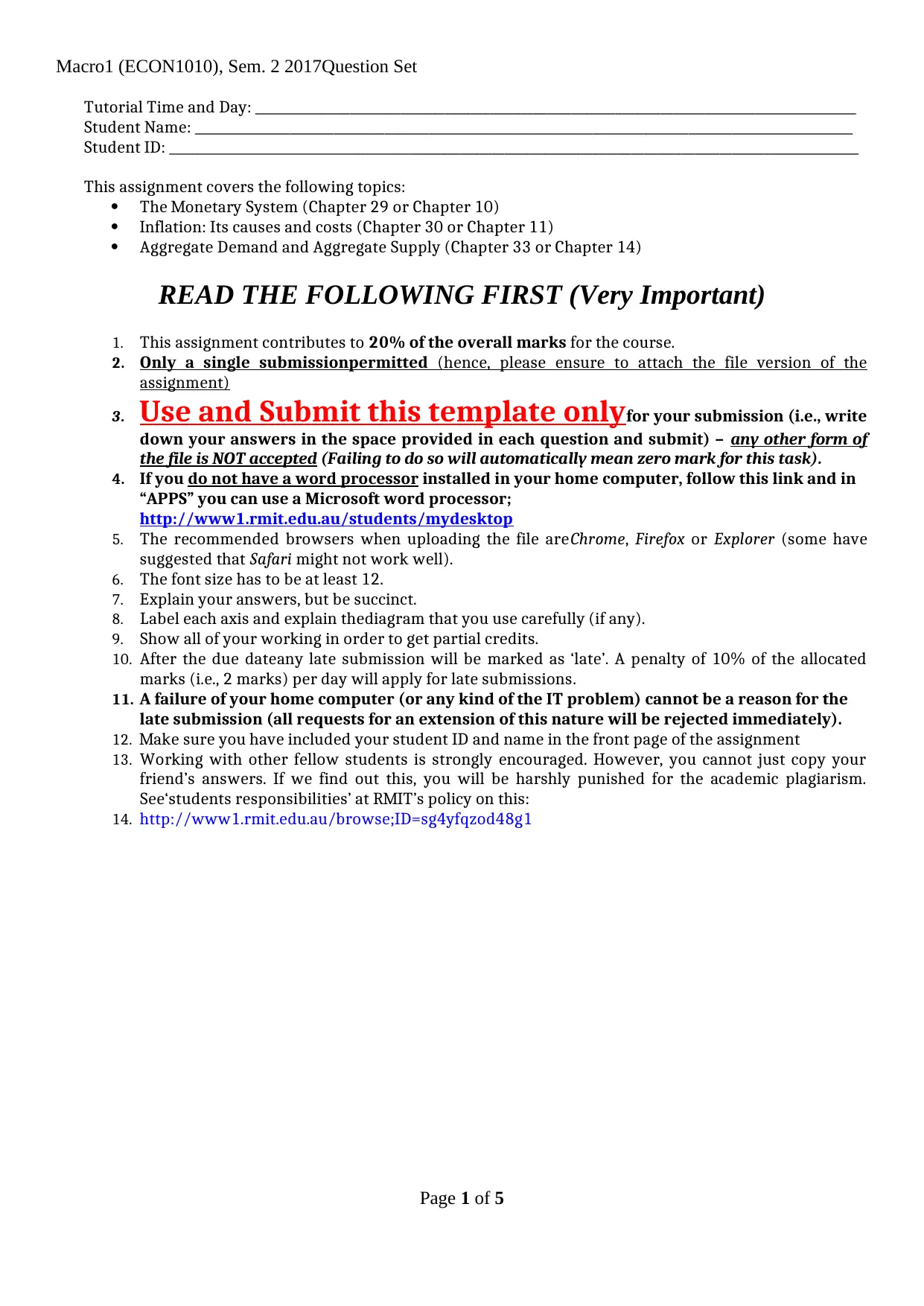
Macro1 (ECON1010), Sem. 2 2017Question Set
Tutorial Time and Day: _______________________________________________________________________________________________
Student Name: ________________________________________________________________________________________________________
Student ID: _____________________________________________________________________________________________________________
This assignment covers the following topics:
The Monetary System (Chapter 29 or Chapter 10)
Inflation: Its causes and costs (Chapter 30 or Chapter 11)
Aggregate Demand and Aggregate Supply (Chapter 33 or Chapter 14)
READ THE FOLLOWING FIRST (Very Important)
1. This assignment contributes to 20% of the overall marks for the course.
2. Only a single submissionpermitted (hence, please ensure to attach the file version of the
assignment)
3. Use and Submit this template onlyfor your submission (i.e., write
down your answers in the space provided in each question and submit) – any other form of
the file is NOT accepted (Failing to do so will automatically mean zero mark for this task).
4. If you do not have a word processor installed in your home computer, follow this link and in
“APPS” you can use a Microsoft word processor;
http://www1.rmit.edu.au/students/mydesktop
5. The recommended browsers when uploading the file areChrome, Firefox or Explorer (some have
suggested that Safari might not work well).
6. The font size has to be at least 12.
7. Explain your answers, but be succinct.
8. Label each axis and explain thediagram that you use carefully (if any).
9. Show all of your working in order to get partial credits.
10. After the due dateany late submission will be marked as ‘late’. A penalty of 10% of the allocated
marks (i.e., 2 marks) per day will apply for late submissions.
11. A failure of your home computer (or any kind of the IT problem) cannot be a reason for the
late submission (all requests for an extension of this nature will be rejected immediately).
12. Make sure you have included your student ID and name in the front page of the assignment
13. Working with other fellow students is strongly encouraged. However, you cannot just copy your
friend’s answers. If we find out this, you will be harshly punished for the academic plagiarism.
See‘students responsibilities’ at RMIT’s policy on this:
14. http://www1.rmit.edu.au/browse;ID=sg4yfqzod48g1
Page 1 of 5
Tutorial Time and Day: _______________________________________________________________________________________________
Student Name: ________________________________________________________________________________________________________
Student ID: _____________________________________________________________________________________________________________
This assignment covers the following topics:
The Monetary System (Chapter 29 or Chapter 10)
Inflation: Its causes and costs (Chapter 30 or Chapter 11)
Aggregate Demand and Aggregate Supply (Chapter 33 or Chapter 14)
READ THE FOLLOWING FIRST (Very Important)
1. This assignment contributes to 20% of the overall marks for the course.
2. Only a single submissionpermitted (hence, please ensure to attach the file version of the
assignment)
3. Use and Submit this template onlyfor your submission (i.e., write
down your answers in the space provided in each question and submit) – any other form of
the file is NOT accepted (Failing to do so will automatically mean zero mark for this task).
4. If you do not have a word processor installed in your home computer, follow this link and in
“APPS” you can use a Microsoft word processor;
http://www1.rmit.edu.au/students/mydesktop
5. The recommended browsers when uploading the file areChrome, Firefox or Explorer (some have
suggested that Safari might not work well).
6. The font size has to be at least 12.
7. Explain your answers, but be succinct.
8. Label each axis and explain thediagram that you use carefully (if any).
9. Show all of your working in order to get partial credits.
10. After the due dateany late submission will be marked as ‘late’. A penalty of 10% of the allocated
marks (i.e., 2 marks) per day will apply for late submissions.
11. A failure of your home computer (or any kind of the IT problem) cannot be a reason for the
late submission (all requests for an extension of this nature will be rejected immediately).
12. Make sure you have included your student ID and name in the front page of the assignment
13. Working with other fellow students is strongly encouraged. However, you cannot just copy your
friend’s answers. If we find out this, you will be harshly punished for the academic plagiarism.
See‘students responsibilities’ at RMIT’s policy on this:
14. http://www1.rmit.edu.au/browse;ID=sg4yfqzod48g1
Page 1 of 5
Paraphrase This Document
Need a fresh take? Get an instant paraphrase of this document with our AI Paraphraser
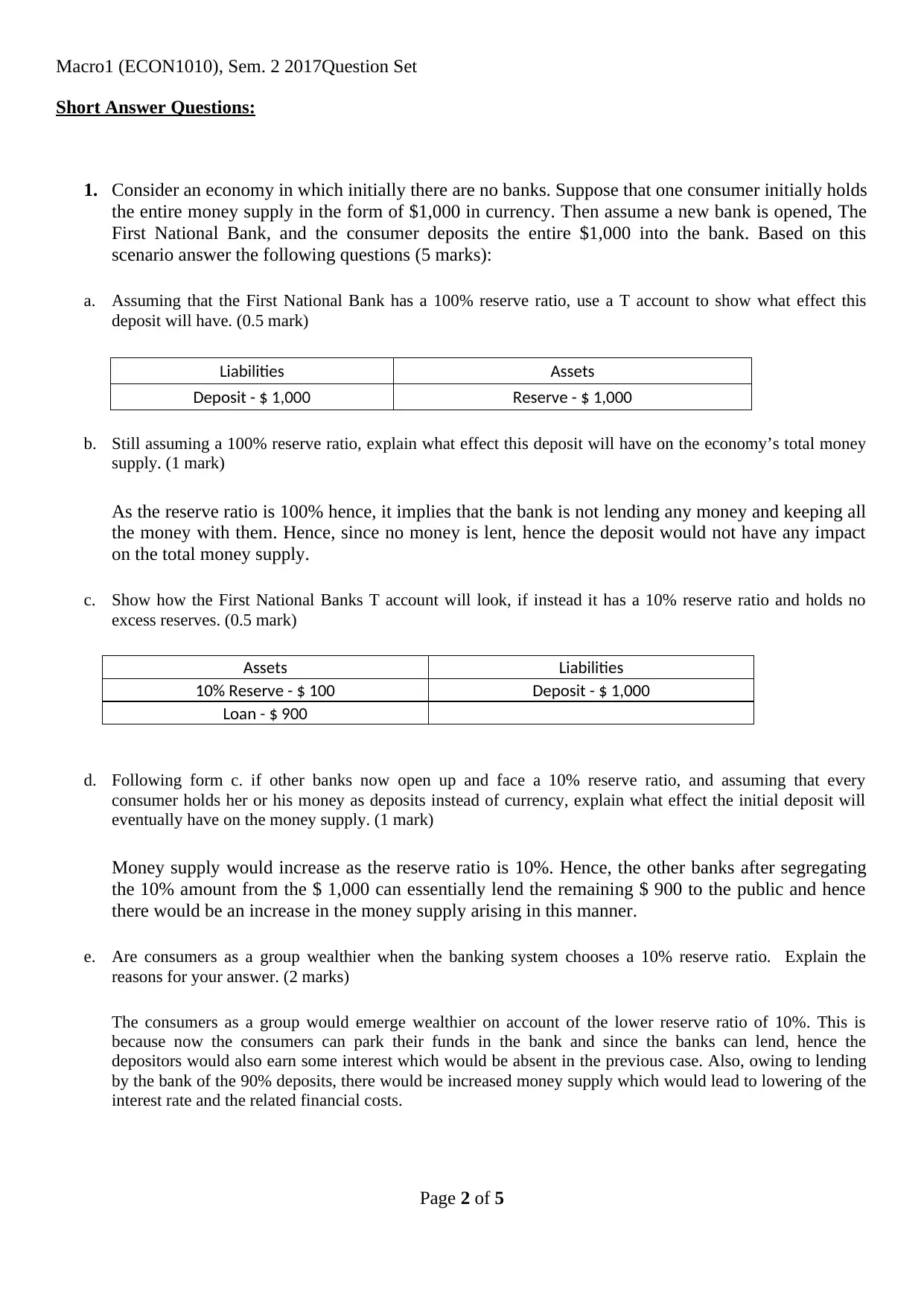
Macro1 (ECON1010), Sem. 2 2017Question Set
Short Answer Questions:
1. Consider an economy in which initially there are no banks. Suppose that one consumer initially holds
the entire money supply in the form of $1,000 in currency. Then assume a new bank is opened, The
First National Bank, and the consumer deposits the entire $1,000 into the bank. Based on this
scenario answer the following questions (5 marks):
a. Assuming that the First National Bank has a 100% reserve ratio, use a T account to show what effect this
deposit will have. (0.5 mark)
Liabilities Assets
Deposit - $ 1,000 Reserve - $ 1,000
b. Still assuming a 100% reserve ratio, explain what effect this deposit will have on the economy’s total money
supply. (1 mark)
As the reserve ratio is 100% hence, it implies that the bank is not lending any money and keeping all
the money with them. Hence, since no money is lent, hence the deposit would not have any impact
on the total money supply.
c. Show how the First National Banks T account will look, if instead it has a 10% reserve ratio and holds no
excess reserves. (0.5 mark)
Assets Liabilities
10% Reserve - $ 100 Deposit - $ 1,000
Loan - $ 900
d. Following form c. if other banks now open up and face a 10% reserve ratio, and assuming that every
consumer holds her or his money as deposits instead of currency, explain what effect the initial deposit will
eventually have on the money supply. (1 mark)
Money supply would increase as the reserve ratio is 10%. Hence, the other banks after segregating
the 10% amount from the $ 1,000 can essentially lend the remaining $ 900 to the public and hence
there would be an increase in the money supply arising in this manner.
e. Are consumers as a group wealthier when the banking system chooses a 10% reserve ratio. Explain the
reasons for your answer. (2 marks)
The consumers as a group would emerge wealthier on account of the lower reserve ratio of 10%. This is
because now the consumers can park their funds in the bank and since the banks can lend, hence the
depositors would also earn some interest which would be absent in the previous case. Also, owing to lending
by the bank of the 90% deposits, there would be increased money supply which would lead to lowering of the
interest rate and the related financial costs.
Page 2 of 5
Short Answer Questions:
1. Consider an economy in which initially there are no banks. Suppose that one consumer initially holds
the entire money supply in the form of $1,000 in currency. Then assume a new bank is opened, The
First National Bank, and the consumer deposits the entire $1,000 into the bank. Based on this
scenario answer the following questions (5 marks):
a. Assuming that the First National Bank has a 100% reserve ratio, use a T account to show what effect this
deposit will have. (0.5 mark)
Liabilities Assets
Deposit - $ 1,000 Reserve - $ 1,000
b. Still assuming a 100% reserve ratio, explain what effect this deposit will have on the economy’s total money
supply. (1 mark)
As the reserve ratio is 100% hence, it implies that the bank is not lending any money and keeping all
the money with them. Hence, since no money is lent, hence the deposit would not have any impact
on the total money supply.
c. Show how the First National Banks T account will look, if instead it has a 10% reserve ratio and holds no
excess reserves. (0.5 mark)
Assets Liabilities
10% Reserve - $ 100 Deposit - $ 1,000
Loan - $ 900
d. Following form c. if other banks now open up and face a 10% reserve ratio, and assuming that every
consumer holds her or his money as deposits instead of currency, explain what effect the initial deposit will
eventually have on the money supply. (1 mark)
Money supply would increase as the reserve ratio is 10%. Hence, the other banks after segregating
the 10% amount from the $ 1,000 can essentially lend the remaining $ 900 to the public and hence
there would be an increase in the money supply arising in this manner.
e. Are consumers as a group wealthier when the banking system chooses a 10% reserve ratio. Explain the
reasons for your answer. (2 marks)
The consumers as a group would emerge wealthier on account of the lower reserve ratio of 10%. This is
because now the consumers can park their funds in the bank and since the banks can lend, hence the
depositors would also earn some interest which would be absent in the previous case. Also, owing to lending
by the bank of the 90% deposits, there would be increased money supply which would lead to lowering of the
interest rate and the related financial costs.
Page 2 of 5
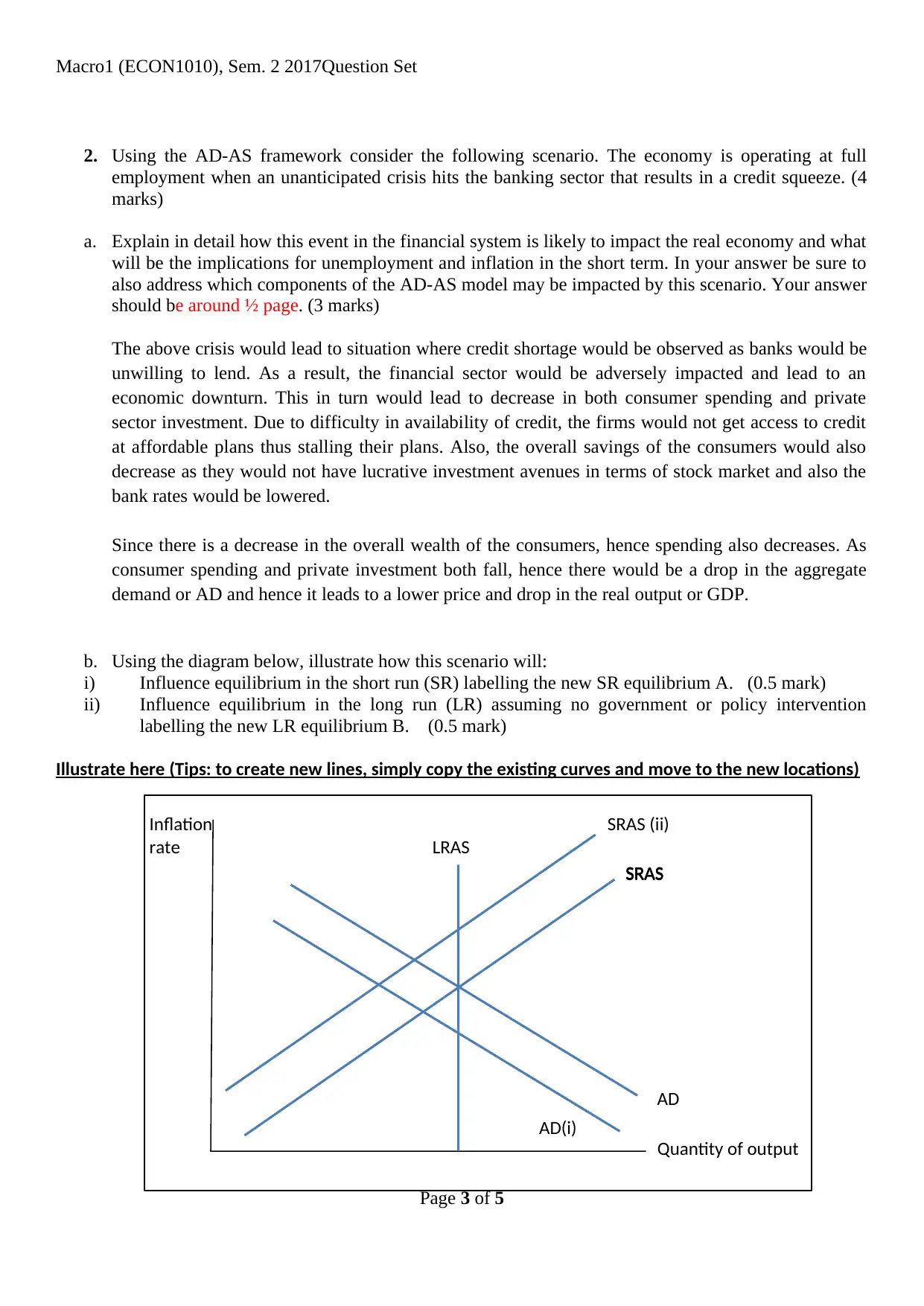
Macro1 (ECON1010), Sem. 2 2017Question Set
2. Using the AD-AS framework consider the following scenario. The economy is operating at full
employment when an unanticipated crisis hits the banking sector that results in a credit squeeze. (4
marks)
a. Explain in detail how this event in the financial system is likely to impact the real economy and what
will be the implications for unemployment and inflation in the short term. In your answer be sure to
also address which components of the AD-AS model may be impacted by this scenario. Your answer
should be around ½ page. (3 marks)
The above crisis would lead to situation where credit shortage would be observed as banks would be
unwilling to lend. As a result, the financial sector would be adversely impacted and lead to an
economic downturn. This in turn would lead to decrease in both consumer spending and private
sector investment. Due to difficulty in availability of credit, the firms would not get access to credit
at affordable plans thus stalling their plans. Also, the overall savings of the consumers would also
decrease as they would not have lucrative investment avenues in terms of stock market and also the
bank rates would be lowered.
Since there is a decrease in the overall wealth of the consumers, hence spending also decreases. As
consumer spending and private investment both fall, hence there would be a drop in the aggregate
demand or AD and hence it leads to a lower price and drop in the real output or GDP.
b. Using the diagram below, illustrate how this scenario will:
i) Influence equilibrium in the short run (SR) labelling the new SR equilibrium A. (0.5 mark)
ii) Influence equilibrium in the long run (LR) assuming no government or policy intervention
labelling the new LR equilibrium B. (0.5 mark)
Illustrate here (Tips: to create new lines, simply copy the existing curves and move to the new locations)
Page 3 of 5
SRAS
Quantity of output
Inflation
rate LRAS
AD
AD(i)
SRASSRASSRAS
SRAS (ii)
2. Using the AD-AS framework consider the following scenario. The economy is operating at full
employment when an unanticipated crisis hits the banking sector that results in a credit squeeze. (4
marks)
a. Explain in detail how this event in the financial system is likely to impact the real economy and what
will be the implications for unemployment and inflation in the short term. In your answer be sure to
also address which components of the AD-AS model may be impacted by this scenario. Your answer
should be around ½ page. (3 marks)
The above crisis would lead to situation where credit shortage would be observed as banks would be
unwilling to lend. As a result, the financial sector would be adversely impacted and lead to an
economic downturn. This in turn would lead to decrease in both consumer spending and private
sector investment. Due to difficulty in availability of credit, the firms would not get access to credit
at affordable plans thus stalling their plans. Also, the overall savings of the consumers would also
decrease as they would not have lucrative investment avenues in terms of stock market and also the
bank rates would be lowered.
Since there is a decrease in the overall wealth of the consumers, hence spending also decreases. As
consumer spending and private investment both fall, hence there would be a drop in the aggregate
demand or AD and hence it leads to a lower price and drop in the real output or GDP.
b. Using the diagram below, illustrate how this scenario will:
i) Influence equilibrium in the short run (SR) labelling the new SR equilibrium A. (0.5 mark)
ii) Influence equilibrium in the long run (LR) assuming no government or policy intervention
labelling the new LR equilibrium B. (0.5 mark)
Illustrate here (Tips: to create new lines, simply copy the existing curves and move to the new locations)
Page 3 of 5
SRAS
Quantity of output
Inflation
rate LRAS
AD
AD(i)
SRASSRASSRAS
SRAS (ii)
⊘ This is a preview!⊘
Do you want full access?
Subscribe today to unlock all pages.

Trusted by 1+ million students worldwide
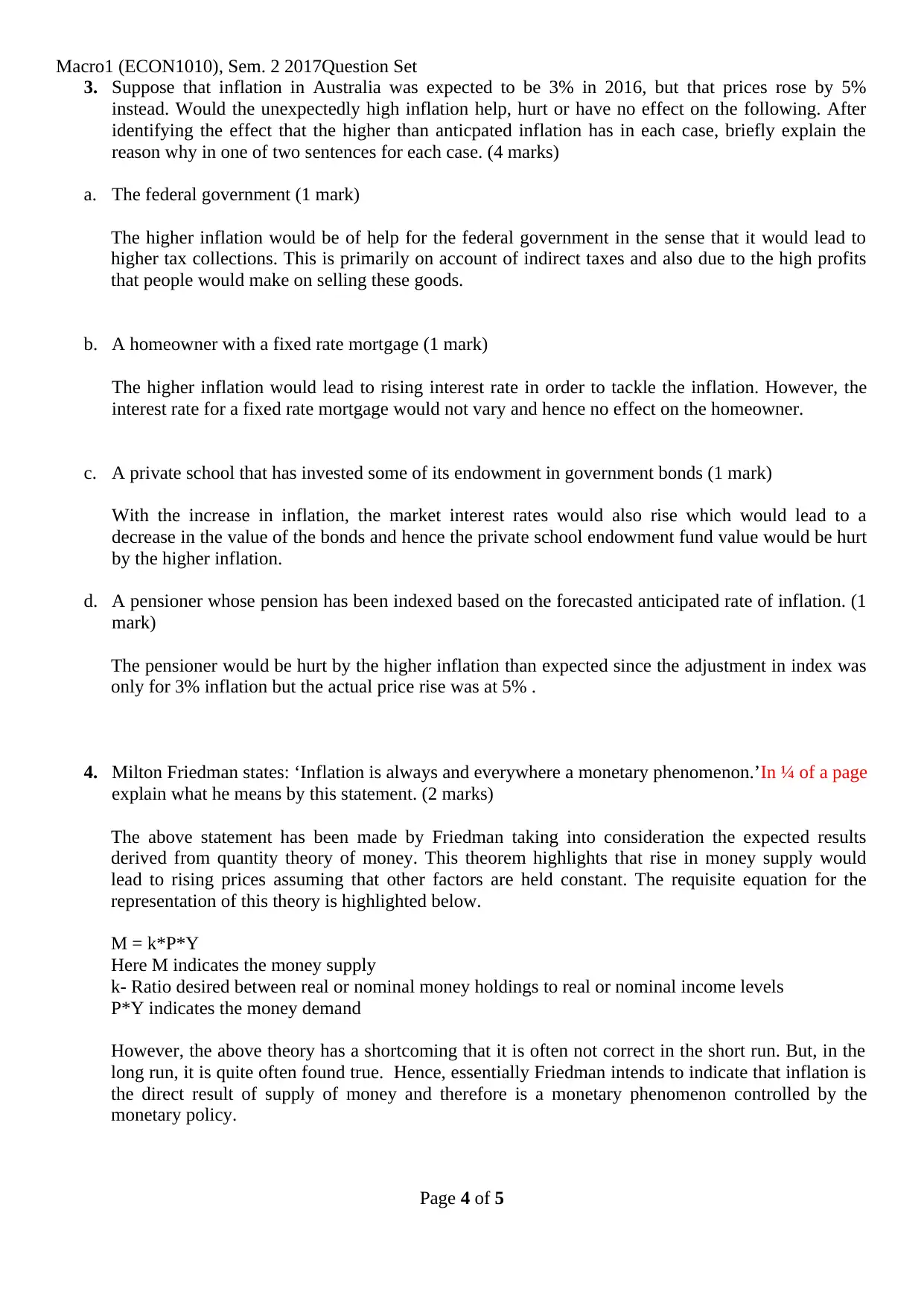
Macro1 (ECON1010), Sem. 2 2017Question Set
3. Suppose that inflation in Australia was expected to be 3% in 2016, but that prices rose by 5%
instead. Would the unexpectedly high inflation help, hurt or have no effect on the following. After
identifying the effect that the higher than anticpated inflation has in each case, briefly explain the
reason why in one of two sentences for each case. (4 marks)
a. The federal government (1 mark)
The higher inflation would be of help for the federal government in the sense that it would lead to
higher tax collections. This is primarily on account of indirect taxes and also due to the high profits
that people would make on selling these goods.
b. A homeowner with a fixed rate mortgage (1 mark)
The higher inflation would lead to rising interest rate in order to tackle the inflation. However, the
interest rate for a fixed rate mortgage would not vary and hence no effect on the homeowner.
c. A private school that has invested some of its endowment in government bonds (1 mark)
With the increase in inflation, the market interest rates would also rise which would lead to a
decrease in the value of the bonds and hence the private school endowment fund value would be hurt
by the higher inflation.
d. A pensioner whose pension has been indexed based on the forecasted anticipated rate of inflation. (1
mark)
The pensioner would be hurt by the higher inflation than expected since the adjustment in index was
only for 3% inflation but the actual price rise was at 5% .
4. Milton Friedman states: ‘Inflation is always and everywhere a monetary phenomenon.’In ¼ of a page
explain what he means by this statement. (2 marks)
The above statement has been made by Friedman taking into consideration the expected results
derived from quantity theory of money. This theorem highlights that rise in money supply would
lead to rising prices assuming that other factors are held constant. The requisite equation for the
representation of this theory is highlighted below.
M = k*P*Y
Here M indicates the money supply
k- Ratio desired between real or nominal money holdings to real or nominal income levels
P*Y indicates the money demand
However, the above theory has a shortcoming that it is often not correct in the short run. But, in the
long run, it is quite often found true. Hence, essentially Friedman intends to indicate that inflation is
the direct result of supply of money and therefore is a monetary phenomenon controlled by the
monetary policy.
Page 4 of 5
3. Suppose that inflation in Australia was expected to be 3% in 2016, but that prices rose by 5%
instead. Would the unexpectedly high inflation help, hurt or have no effect on the following. After
identifying the effect that the higher than anticpated inflation has in each case, briefly explain the
reason why in one of two sentences for each case. (4 marks)
a. The federal government (1 mark)
The higher inflation would be of help for the federal government in the sense that it would lead to
higher tax collections. This is primarily on account of indirect taxes and also due to the high profits
that people would make on selling these goods.
b. A homeowner with a fixed rate mortgage (1 mark)
The higher inflation would lead to rising interest rate in order to tackle the inflation. However, the
interest rate for a fixed rate mortgage would not vary and hence no effect on the homeowner.
c. A private school that has invested some of its endowment in government bonds (1 mark)
With the increase in inflation, the market interest rates would also rise which would lead to a
decrease in the value of the bonds and hence the private school endowment fund value would be hurt
by the higher inflation.
d. A pensioner whose pension has been indexed based on the forecasted anticipated rate of inflation. (1
mark)
The pensioner would be hurt by the higher inflation than expected since the adjustment in index was
only for 3% inflation but the actual price rise was at 5% .
4. Milton Friedman states: ‘Inflation is always and everywhere a monetary phenomenon.’In ¼ of a page
explain what he means by this statement. (2 marks)
The above statement has been made by Friedman taking into consideration the expected results
derived from quantity theory of money. This theorem highlights that rise in money supply would
lead to rising prices assuming that other factors are held constant. The requisite equation for the
representation of this theory is highlighted below.
M = k*P*Y
Here M indicates the money supply
k- Ratio desired between real or nominal money holdings to real or nominal income levels
P*Y indicates the money demand
However, the above theory has a shortcoming that it is often not correct in the short run. But, in the
long run, it is quite often found true. Hence, essentially Friedman intends to indicate that inflation is
the direct result of supply of money and therefore is a monetary phenomenon controlled by the
monetary policy.
Page 4 of 5
Paraphrase This Document
Need a fresh take? Get an instant paraphrase of this document with our AI Paraphraser
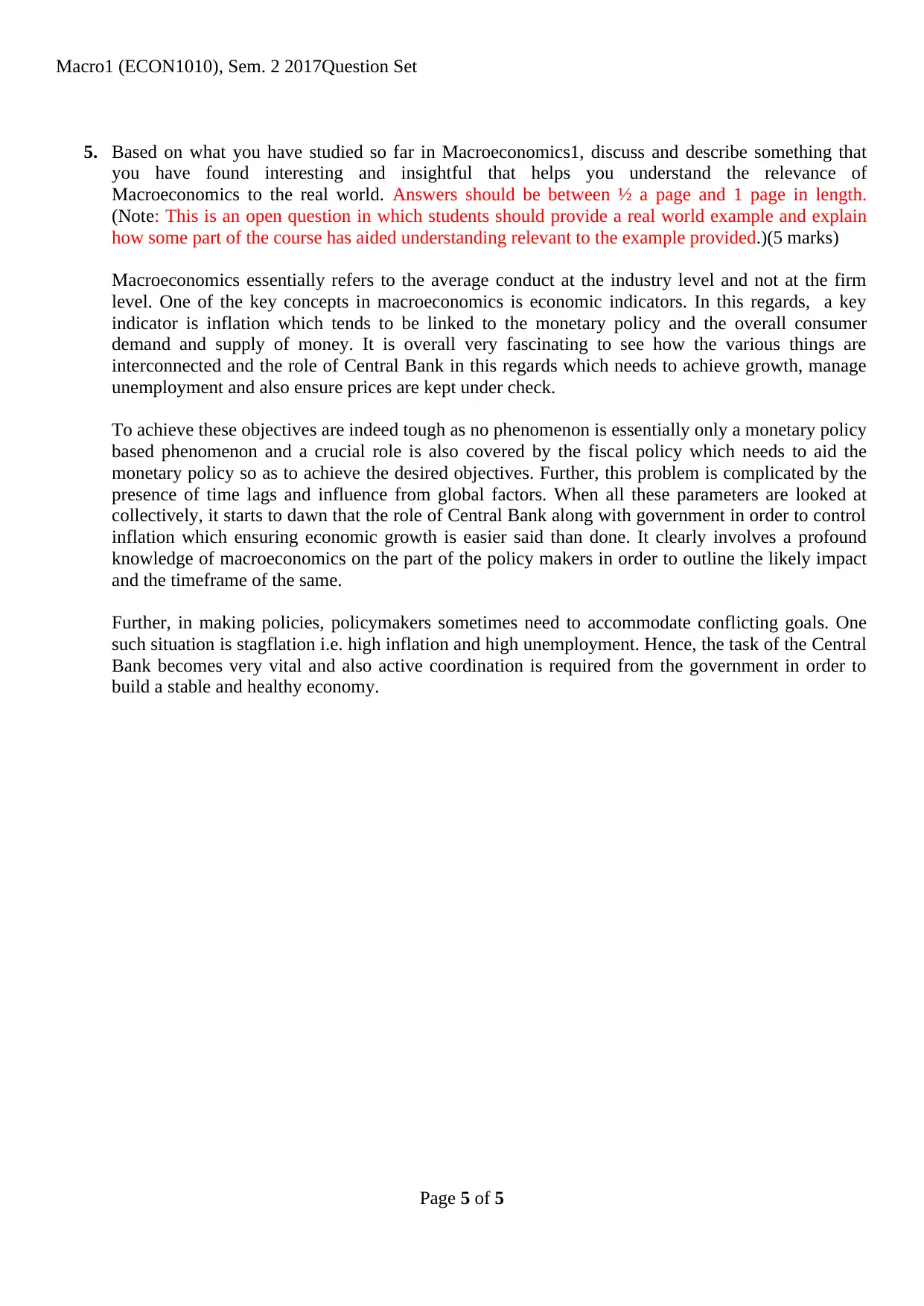
Macro1 (ECON1010), Sem. 2 2017Question Set
5. Based on what you have studied so far in Macroeconomics1, discuss and describe something that
you have found interesting and insightful that helps you understand the relevance of
Macroeconomics to the real world. Answers should be between ½ a page and 1 page in length.
(Note: This is an open question in which students should provide a real world example and explain
how some part of the course has aided understanding relevant to the example provided.)(5 marks)
Macroeconomics essentially refers to the average conduct at the industry level and not at the firm
level. One of the key concepts in macroeconomics is economic indicators. In this regards, a key
indicator is inflation which tends to be linked to the monetary policy and the overall consumer
demand and supply of money. It is overall very fascinating to see how the various things are
interconnected and the role of Central Bank in this regards which needs to achieve growth, manage
unemployment and also ensure prices are kept under check.
To achieve these objectives are indeed tough as no phenomenon is essentially only a monetary policy
based phenomenon and a crucial role is also covered by the fiscal policy which needs to aid the
monetary policy so as to achieve the desired objectives. Further, this problem is complicated by the
presence of time lags and influence from global factors. When all these parameters are looked at
collectively, it starts to dawn that the role of Central Bank along with government in order to control
inflation which ensuring economic growth is easier said than done. It clearly involves a profound
knowledge of macroeconomics on the part of the policy makers in order to outline the likely impact
and the timeframe of the same.
Further, in making policies, policymakers sometimes need to accommodate conflicting goals. One
such situation is stagflation i.e. high inflation and high unemployment. Hence, the task of the Central
Bank becomes very vital and also active coordination is required from the government in order to
build a stable and healthy economy.
Page 5 of 5
5. Based on what you have studied so far in Macroeconomics1, discuss and describe something that
you have found interesting and insightful that helps you understand the relevance of
Macroeconomics to the real world. Answers should be between ½ a page and 1 page in length.
(Note: This is an open question in which students should provide a real world example and explain
how some part of the course has aided understanding relevant to the example provided.)(5 marks)
Macroeconomics essentially refers to the average conduct at the industry level and not at the firm
level. One of the key concepts in macroeconomics is economic indicators. In this regards, a key
indicator is inflation which tends to be linked to the monetary policy and the overall consumer
demand and supply of money. It is overall very fascinating to see how the various things are
interconnected and the role of Central Bank in this regards which needs to achieve growth, manage
unemployment and also ensure prices are kept under check.
To achieve these objectives are indeed tough as no phenomenon is essentially only a monetary policy
based phenomenon and a crucial role is also covered by the fiscal policy which needs to aid the
monetary policy so as to achieve the desired objectives. Further, this problem is complicated by the
presence of time lags and influence from global factors. When all these parameters are looked at
collectively, it starts to dawn that the role of Central Bank along with government in order to control
inflation which ensuring economic growth is easier said than done. It clearly involves a profound
knowledge of macroeconomics on the part of the policy makers in order to outline the likely impact
and the timeframe of the same.
Further, in making policies, policymakers sometimes need to accommodate conflicting goals. One
such situation is stagflation i.e. high inflation and high unemployment. Hence, the task of the Central
Bank becomes very vital and also active coordination is required from the government in order to
build a stable and healthy economy.
Page 5 of 5
1 out of 5
Related Documents
Your All-in-One AI-Powered Toolkit for Academic Success.
+13062052269
info@desklib.com
Available 24*7 on WhatsApp / Email
![[object Object]](/_next/static/media/star-bottom.7253800d.svg)
Unlock your academic potential
Copyright © 2020–2025 A2Z Services. All Rights Reserved. Developed and managed by ZUCOL.





